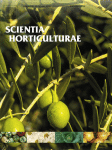View Item
- xmlui.general.dspace_homeCentros Regionales y EEAsCentro Regional Mendoza - San JuanEEA JunínArtículos científicosxmlui.ArtifactBrowser.ItemViewer.trail
- DSpace Home
- Centros Regionales y EEAs
- Centro Regional Mendoza - San Juan
- EEA Junín
- Artículos científicos
- View Item
Vegetative structure and distribution of oil yield components and fruit characteristics within olive hedgerows (cv. Arbosana) mechanically pruned annually on alternating sides in San Juan, Argentina
Abstract
In olive hedgerows mechanical pruning is needed to control hedgerow dimensions for canopy illumination and access by harvesting machinery but yield responses to pruning strategies remain unclear. This study records the impact of annual mechanical topping with pruning on alternating sides of hedgerows on the internal distribution of fruit characteristics and oil yield. Hedging was applied in winter at 0.4 m from the trunk on West and East sides in 2015–16
[ver mas...]
In olive hedgerows mechanical pruning is needed to control hedgerow dimensions for canopy illumination and access by harvesting machinery but yield responses to pruning strategies remain unclear. This study records the impact of annual mechanical topping with pruning on alternating sides of hedgerows on the internal distribution of fruit characteristics and oil yield. Hedging was applied in winter at 0.4 m from the trunk on West and East sides in 2015–16 and 2016–17 seasons, respectively, along with topping at 3.0 m height. Hedgerow width, height and porosity were characterized after pruning and before harvest. Oil production, fruit number and fruit characteristics were evaluated in 20 positions within the hedgerows defined by two sides (East and West), two depths per side (inner and outer) and 5 heights. West-unpruned sides in 2015–16 and East-unpruned sides in 2016–17 produced 70 and 80% of the total oil, respectively. Within each season, fruit oil and water concentration and pulp/pit ratio were similar on opposing sides. In contrast, fruit weight and maturity were similar between sides in 2015–16 but not in 2016–17 where greater fruit weight and more advanced maturity were observed on West-pruned. In both seasons, inner positions (within 0.5 m of trunk) produced 65% of total oil production and fruit numbers. Fruits showed similar characteristics between hedgerow depths. In contrast, oil production and fruit characteristics showed a marked gradient with height. Oil production and fruit number were greatest from 1.0 to 2.0 m height, decreasing to the top and to the base. Fruit weight, oil concentration and maturity decreased from hedgerow top to base, while fruit water concentration showed the opposite pattern. Mechanical pruning applied annually to alternating sides maintained both hedgerow dimensions and oil yield in successive years.
[Cerrar]

Fuente
Scientia Horticulturae 240 : 425–429 (2018)
Date
2018
ISSN
0304-4238
Formato
pdf
Tipo de documento
artículo
Palabras Claves
Derechos de acceso
Restringido
 Excepto donde se diga explicitamente, este item se publica bajo la siguiente descripción: Creative Commons Attribution-NonCommercial-ShareAlike 2.5 Unported (CC BY-NC-SA 2.5)
Excepto donde se diga explicitamente, este item se publica bajo la siguiente descripción: Creative Commons Attribution-NonCommercial-ShareAlike 2.5 Unported (CC BY-NC-SA 2.5)

